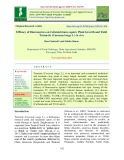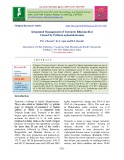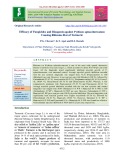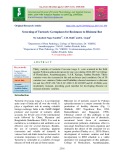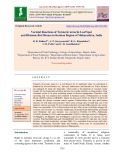
Rhizome rot of turmeric
-
Turmeric (Curcuma longa L.), is an important and economical medicinal and aromatic crop, prone to many fungal, bacterial, viral and nematode diseases. The most important fungal diseases are leaf spot (Colletotrichum capsici), leaf blotch (Taphrina maculans), rhizome rot (Pythium aphanidermatum) etc.,
 8p
8p  chauchaungayxua11
chauchaungayxua11
 23-03-2021
23-03-2021
 8
8
 1
1
 Download
Download
-
Turmeric (Curcuma longa L) rhizome rot caused by Pythium aphanidermatum was one of the divesting disease and causes accountable losses. All fungicides, bioagents, botanicals and soil amendments (alone and in combination) tested in vitro for management of turmeric rhizome rot was found effective against P. aphanidermatum.
 7p
7p  trinhthamhodang1218
trinhthamhodang1218
 26-02-2021
26-02-2021
 10
10
 2
2
 Download
Download
-
The disease has been reported to causes more than 60 per cent mortality of seedlings both in nursery and field condition and about 50-80 per cent losses during storage (Nirmal, 1992); rhizome rot resulted in yield loss of 50% (Rajalakshmi et al., 2016).
 9p
9p  trinhthamhodang1218
trinhthamhodang1218
 26-02-2021
26-02-2021
 11
11
 1
1
 Download
Download
-
Thirty varieties of turmeric Curcuma longa L. were screened in the field against Pythium aphanidermatum for one year during 2016-2017 at College of Horticulture, Anantharajupeta, Y.S.R. Kadapa, Andhra Pradesh. These varieties were also screened in lab and net house (pot) condition. Out of 30 varieties two varieties (Salem and Prathibha) showed resistance to rhizome rot and five (TCP-129, VK-9, IC-330113, IC-033007 and IC-212606) were moderately resistant, providing good material for developing rhizome rot resistant turmeric varieties.
 9p
9p  cothumenhmong9
cothumenhmong9
 18-01-2021
18-01-2021
 11
11
 2
2
 Download
Download
-
Forty turmeric genotypes collected from different parts of the country including two recommended varieties as checks viz. Palam Lalima and Palam Pitambar were planted at the Experimental Farm of the Department of Vegetable Science, Dr. YS Parmar University of Horticulture and Forestry, Nauni, Solan (HP) during Kharif season of 2011 and evaluated for different yield and yield contributing traits.
 9p
9p  trinhthamhodang1215
trinhthamhodang1215
 23-09-2020
23-09-2020
 11
11
 1
1
 Download
Download
-
Bacteria producing biosurfactant molecules is beneficial to manage rhizome rot of turmeric caused by Pythium spp. A detailed study was conducted on biosurfactant producing bacteria for management of rhizome rot of turmeric. Initially, a survey was conducted to find out the incidence of the disease in turmeric growing of areas of Tamil Nadu, it was observed that rhizome rot in turmeric was also ranged from 9.16 to 71.55 and the maximum incidence was noticed in Ammampalayam (71.55%).
 10p
10p  angicungduoc4
angicungduoc4
 26-04-2020
26-04-2020
 7
7
 1
1
 Download
Download
-
Nine botanicals were evaluated for their antifungal activity against Fusarium solani causing root rot disease in Bael by employing poisoned food technique under laboratory conditions. The results indicated that all the botanicals inhibited the growth of the Fusarium solani as compared to control. Out of nine botanical tested, turmeric rhizome extract was found most effective as it showed minimum mycelial growth (33.3 mm, 20.7 mm and 13.5 mm) and maximum mycelial growth inhibition (63.1 %, 77.0 % and 85.
 7p
7p  angicungduoc4
angicungduoc4
 26-04-2020
26-04-2020
 6
6
 0
0
 Download
Download
-
Turmeric is one of the important spice crops grown in India. Root-knot nematode (Meloidogyne spp.) is a major problem, which causes galls/knots in the rhizomes and causes considerable yield loses. It also makes the way for the secondary infection by different pathogens like Pythium, Fusarium and Ralstonia in the soil. Yield losses due to nematode infestation are reported in turmeric-growing areas. A roving survey was conducted for incidence of root-knot nematode in turmeric during kharif season in 2016 at Belagavi, Bagalkot, Chamarajanagar and Kalburgi districts of Karnataka.
 10p
10p  trinhthamhodang4
trinhthamhodang4
 22-03-2020
22-03-2020
 10
10
 0
0
 Download
Download
-
Turmeric (Curcuma longa L.) is well known for its medicinal value, its cultivation is hindered by several diseases viz., leaf spot, anthracnose and rhizome rot. These diseases are managed by using the fungicides, which leads to development of resistant strains besides the environmental pollution and also the residue problem on final produce.
 7p
7p  caygaocaolon2
caygaocaolon2
 14-03-2020
14-03-2020
 8
8
 1
1
 Download
Download
-
On farm trials in ten locations were conducted to evaluate efficacy of IDM practices with emphasis on use of bio-control gents for management of rhizome rot in turmeric and to create awareness among the farming community on rhizome rot management during Kharif, 2014-15 to 2016-17 in the farmer’s fields in Krishna District of Andhra Pradesh.
 7p
7p  cothumenhmong1
cothumenhmong1
 11-12-2019
11-12-2019
 8
8
 0
0
 Download
Download
CHỦ ĐỀ BẠN MUỐN TÌM









